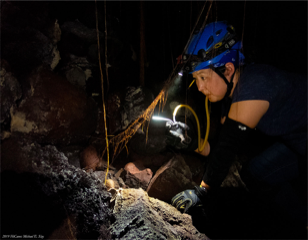Subterranean Biodiversity and Food Web Complexity of the Island of Hawai’i: insights into the evolution and diversification of cave-adapted planthoppers
Dr. Becky Chong
March 24, 2021
4-5pm
Hosted By Dr. Kasie Raymann
Island lava tube faunas harbor interesting arthropod community assemblages with complex food webs based on nutrients provided by roots from the native ‘Ohi’a lehua tree (Metrosideros polymorpha). These sensitive ecosystems represent hotspots for understudied biodiversity. We focus on understanding the subterranean biodiversity of the Island of Hawai’i in the context of community assemblages from different volcanic flows. To date, 74 troglobiont species have been described from across the main Hawaiian islands. Of these species, 44 have been documented on the Island of Hawai’i. Cave-adapted species of several genera that are found in lava tubes from multiple volcanic systems (e.g. Kilauea, Mauna Loa, Hualalai), indicating that either similar species assemblages have evolved independently over time, or there are complicated routes of dispersal among flows from separate volcanoes. Bioinventories from this system have documented significant range expansions for previously described species, and have revealed new cave-adapted species, including undescribed and cryptic cave-adapted planthopper species (Cixiidae). Understanding subterranean planthopper biodiversity is critical for subterranean conservation efforts as they represent a keystone species within lava tube ecosystems. Planthoppers harbor obligate microbial partners that provision essential amino acids and vitamins that are lacking in nutrient poor plant sap of ‘Ohi’a roots, and thus represent an important trophic level in the food web. Based on preliminary genetic work, we find evidence for distinct and divergent planthopper populations across lava tube systems found in different aged flows. Conservation of Ohi’a forests on the surface is needed to protect planthoppers diversity and their unique subterranean ecosystems.
